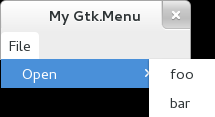Menu
Object Hierarchy:
Description:
A Menu is a MenuShell that implements a drop down menu consisting of a list of MenuItem objects which can be navigated and activated by the user to perform application functions.
A Menu is most commonly dropped down by activating a MenuItem in a MenuBar or popped up by activating a MenuItem in another Menu.
A Menu can also be popped up by activating a ComboBox. Other composite widgets such as the Notebook can pop up a Menu as well.
Applications can display a Menu as a popup menu by calling the popup function. The example below shows how an application can pop up a menu when the 3rd mouse button is pressed.
Connecting the popup signal handler.
// connect our handler which will popup the menu
g_signal_connect_swapped (window, "button_press_event",
G_CALLBACK (my_popup_handler), menu);Signal handler which displays a popup menu.
static gint
my_popup_handler (GtkWidget *widget, GdkEvent *event)
{
GtkMenu *menu;
GdkEventButton *event_button;
g_return_val_if_fail (widget != NULL, FALSE);
g_return_val_if_fail (GTK_IS_MENU (widget), FALSE);
g_return_val_if_fail (event != NULL, FALSE);
// The "widget" is the menu that was supplied when
// g_signal_connect_swapped() was called.
menu = GTK_MENU (widget);
if (event->type == GDK_BUTTON_PRESS)
{
event_button = (GdkEventButton *) event;
if (event_button->button == GDK_BUTTON_SECONDARY)
{
gtk_menu_popup (menu, NULL, NULL, NULL, NULL,
event_button->button, event_button->time);
return TRUE;
}
}
return FALSE;
}CSS nodes
menu
├── arrow.top
├── <child>
┊
├── <child>
╰── arrow.bottomExample: Menu:

public class Application : Gtk.Window {
public Application () {
// Prepare Gtk.Window:
this.title = "My Gtk.Menu";
this.window_position = Gtk.WindowPosition.CENTER;
this.destroy.connect (Gtk.main_quit);
// MenuBar:
Gtk.MenuBar bar = new Gtk.MenuBar ();
this.add (bar);
// File:
Gtk.MenuItem item_file = new Gtk.MenuItem.with_label ("File");
bar.add (item_file);
Gtk.Menu filemenu = new Gtk.Menu ();
item_file.set_submenu (filemenu);
Gtk.MenuItem item_open = new Gtk.MenuItem.with_label ("Open");
filemenu.add (item_open);
// Submenu:
Gtk.Menu submenu = new Gtk.Menu ();
item_open.set_submenu (submenu);
Gtk.MenuItem item_foo = new Gtk.MenuItem.with_label ("foo");
submenu.add (item_foo);
Gtk.MenuItem item_bar = new Gtk.MenuItem.with_label ("bar");
submenu.add (item_bar);
}
public static int main (string[] args) {
Gtk.init (ref args);
Application app = new Application ();
app.show_all ();
Gtk.main ();
return 0;
}
}valac --pkg gtk+-3.0 Gtk.Menu.valaAll known sub-classes:
Namespace: Gtk
Package: gtk+-3.0
Content:
Properties:
Static methods:
Creation methods:
Methods:
Signals:
Inherited Members:
All known members inherited from class Gtk.MenuShell
All known members inherited from class Gtk.Container
All known members inherited from class Gtk.Widget
All known members inherited from class GLib.Object
All known members inherited from interface Atk.Implementor
All known members inherited from interface Gtk.Buildable